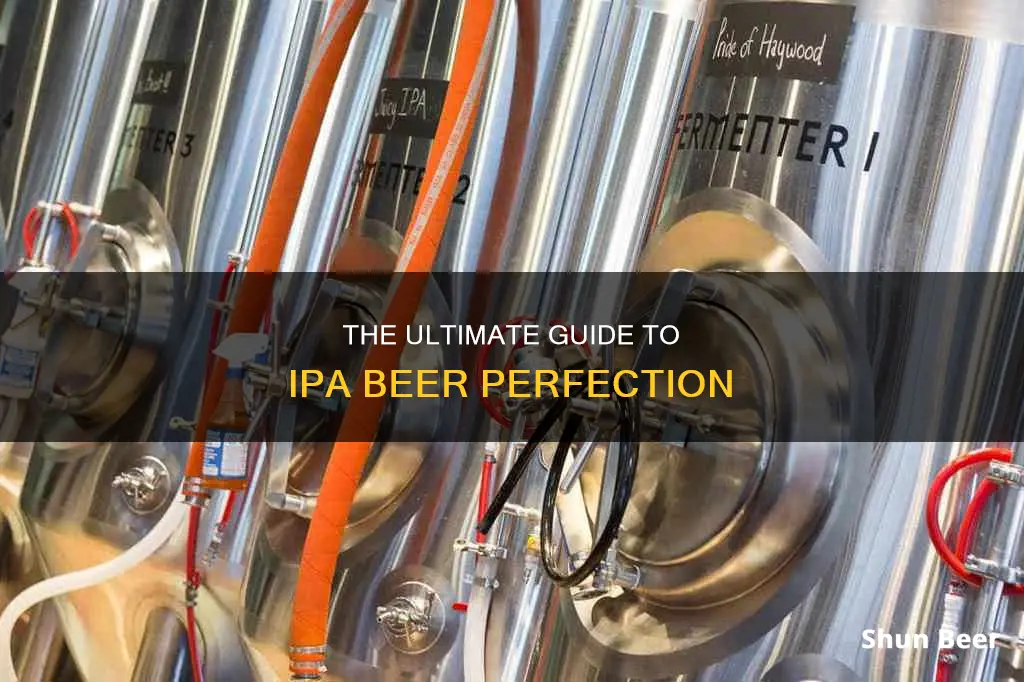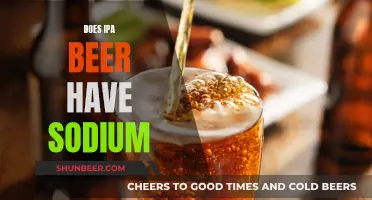
India Pale Ale (IPA) is a hoppy beer style within the broader category of pale ale. It is the most popular craft-beer style in the United States and has become increasingly popular in the UK. The style was originally an export beer shipped to India, which was under the control of the British East India Company until 1858.
IPAs are known for their hoppiness and bitterness, but not all IPAs are bitter. The style has evolved to include a range of fruity flavours, with modern IPAs exploring less bitter, fruit-forward profiles.
Homebrewing IPAs is a popular pursuit, and while it can be a little complicated, it is entirely possible to create rich and hugely satisfying hop-forward beers at home.
How to IPA Beer
| Characteristics | Values |
|---|---|
| Style | New England IPA, British IPA, West Coast IPA, East Coast IPA, Belgian IPA, Fruited IPA, Sour IPA, Brett IPA, Black IPA, Brut IPA, Double IPA, Triple IPA, White IPA, India Pale Lager, Cold IPA |
| Alcohol Content | Varies depending on the style. Session IPAs are usually below 5% ABV, while Double IPAs are over 7% ABV. |
| Bitterness | Bitterness varies across styles, with West Coast IPAs being known for their bitterness. However, the trend is shifting towards less bitter IPAs. |
| Hop Character | Hops are the key ingredient in IPAs, contributing to bitterness, flavour, and aroma. Different varieties of hops provide distinct characteristics, such as citrus, pine, fruity, or herbal notes. |
| Malt | While hops take centre stage in IPAs, the choice of malt can also impact the beer's flavour and body. Pale malt is commonly used, but other specialty malts like crystal malt or cara-malt can be added in small amounts. |
| Yeast | Yeast selection depends on the desired style and can influence the beer's flavour and aroma. Common yeast strains include Chico, Conan (Vermont IPA strain), and WLP001 California Ale. |
| Freshness | Using fresh, in-season hops is crucial for a great IPA. Hops should be stored cold and vacuum-sealed to preserve their quality. |
| Dry Hopping | Dry hopping, or adding hops during fermentation, enhances the hop character and can create softer, fruitier flavours. |
| Brewing Process | Maintaining proper temperatures during mashing and fermentation is essential for a successful IPA. Oxygen exposure should be minimised to prevent spoilage. |
What You'll Learn

Choosing the right hops
Type of IPA
The first step is to decide on the type of IPA you want to brew. Do you want a bold and bitter West Coast-style IPA or a fruity and juicy New England-style IPA? Your choice will guide the types of hops you select. For a classic West Coast IPA, you might choose hops like Chinook, Citra, Simcoe, Centennial, or Columbus. If you're leaning towards a New England IPA, Citra, Simcoe, Mosaic, and Amarillo are popular choices.
Hop Characteristics
When choosing hops, consider the specific characteristics they will bring to your beer. Hops can contribute a range of flavours and aromas, from citrus and grapefruit to pine, berry, and tropical fruit. For example, Citra hops are known for their strong citrus and grapefruit notes, while Simcoe hops offer intense berry flavours. Experiment with different hops to find unique combinations that complement each other.
Hop Function
Hops have different functions in the brewing process, and you'll need to select hops for bittering, flavour, aroma, or dry hopping. Bittering hops provide the alpha acids that give your IPA its signature bitterness. Flavour and aroma hops add depth and complexity to the beer's flavour and aroma profile. Dry hopping involves adding hops after fermentation to enhance the aroma and create a more nuanced flavour profile.
Hop Intensity
Consider the intensity of the hops and how they will balance with the other ingredients in your beer. For a session IPA, you might want to use lower alpha acid hops to create a more balanced beer with lower alcohol intensity. In contrast, a double or imperial IPA might call for more intense, high alpha acid hops to stand up to the higher alcohol content.
Experimentation
Don't be afraid to experiment with different hops and combinations. Brewing your own IPA is a creative process, and sometimes the best results come from trying something new. You can also refer to popular IPA recipes or seek advice from other homebrewers to get ideas for hop combinations that work well together.
Remember, the key to choosing the right hops is to understand your desired flavour profile, the function of each hop, and how different hops can be combined to create a well-rounded and delicious IPA.
Guinness Beer: High-Fructose Corn Syrup Content Explored
You may want to see also

Timing your hop additions
When brewing an IPA, the timing of your hop additions is crucial to achieving the desired balance of bitterness, flavour, and aroma. Here are some detailed instructions and tips for timing your hop additions:
Early Boil Hops (45-90 Minutes):
The primary purpose of early boil hops is to impart a firm bitterness to the beer, which is essential for IPAs that aim for a balance between bitterness and malty sweetness. Adding hops early in the boil also offers other benefits, such as preventing boilovers by dispersing the foam. Even if you're aiming for a juicy IPA or one that requires low bitterness, it's recommended to add a small amount of hops early in the boil. High alpha acid hops are typically preferred for this stage to achieve the desired level of bitterness while minimising vegetal matter.
Mid-Boil Hops (15-45 Minutes):
Mid-boil hops were traditionally used to contribute less volatile hop oils and some bittering components. However, in modern IPA recipes, these additions have fallen out of favour as they can still add a significant amount of bitterness. If bitterness is not a concern for the style you're brewing, mid-boil hops can add positive hop character to your IPA. A technique called hop bursting involves replacing early boil hops with a larger dose of hops added for bitterness and flavour in the 20-30 minute range.
Late-Boil Hops (0-15 Minutes):
This stage is crucial for developing the character of modern IPAs. Late-boil hops contribute to the aroma and flavour of the beer. While high-alpha, lower-priced hops can be used in early or mid-boil additions, this stage typically utilises hops that are more prized for their aromatic qualities. The addition of late-boil hops has increased in modern IPA recipes, with amounts ranging from 2-6 oz (57-170 g) per 5 gallons (19 L) being common. It's worth noting that adding these hops during the boil can contribute more bitterness, so brewers may opt to add them after the boil or once the wort has cooled slightly.
Dry Hops:
Dry hopping is a crucial step in brewing IPAs, and the timing, type of hops, and addition technique can vary depending on the desired outcome. Hazy IPAs often receive a first dry hop addition during fermentation and a second addition after fermentation is complete. Non-hazy IPAs, on the other hand, typically wait until after fermentation is complete and the yeast has dropped from suspension to add dry hops, resulting in a more raw hop character. The length of dry hopping also varies, typically ranging from 3 to 10 days, as too long of a contact time can introduce undesirable vegetal or grassy flavours.
First Wort Hops (FWH):
First wort hopping involves adding hops to the boil kettle as the sweet wort is draining from the mash. This technique provides a longer contact time for the hops, resulting in increased bitterness. Generally, the longer the hops are in the boil, the more bitter the beer becomes, which is measured using International Bitterness Units (IBU). Hops with higher alpha acids (AA) will create more bitterness than those with lower AA levels.
Exploring IPAs: Beer Styles and Tasting Notes
You may want to see also

Using a secondary fermenter
Secondary fermentation is a period of aging that occurs after transferring your fermented beer to a secondary vessel. This process is also known as the conditioning phase, as there is very little to no yeast activity. It allows the beer's flavours and aromas to mellow and lets the yeast drop out of solution, producing a clearer finished product.
Secondary fermentation is almost always used for higher-gravity and highly hopped beers that need time to age before reaching their peak flavour and aroma. It is also necessary when adding dry hops or oak chips to your beer.
The duration of secondary fermentation can vary from a week to over six months. You should let your taste buds and nose determine when the beer is ready for bottling. During extended secondary fermentation, ensure your airlock does not dry out. For this reason, a bubbler airlock is best for secondary fermentations.
Many brewers believe that secondary fermentation is unnecessary, and an extended primary fermentation of 3-4 weeks will produce the same results. However, this has not been proven through extensive studies.
Booze in Beer: IPAs Boomsauce Alcoholic Secrets
You may want to see also

Selecting the right yeast
Yeast is a crucial component in brewing beer, and with the popularity of IPAs, it's important to choose the right strain to bring out the desired flavours. The type of yeast used will depend on the specific style of IPA being brewed and the desired level of expression from the hops.
Lager or Ale Yeast
The first distinction to make when selecting a yeast strain is whether to use lager or ale yeast. Lager yeast, or Saccharomyces pastorianus, works at lower temperatures, typically between 8-15°C (46-59°F), and is bottom fermenting. It gives the beer a clean and crisp taste. Ale yeast, or Saccharomyces cerevisiae, on the other hand, works best at room temperature (18-22°C or 64-71°F) and often has a higher alcohol tolerance. Ale yeast is top fermenting and produces slightly fruity characteristics, which are commonly found in many ales.
Yeast Strains for IPA
When it comes to IPAs, yeast strains with clean and neutral fermentation profiles are generally preferred to let the hops shine. The classic yeast for American IPAs is the Chico strain, which includes Wyeast 1056, White Labs WLP001, and Safale US-05. These yeasts have very clean and crisp flavour characteristics with low fruitiness, making them versatile choices.
For a softer, cleaner profile with hints of nut and a slightly tart finish, Wyeast American Ale II 1272 is a good choice. Fermenting at warmer temperatures with this yeast will accentuate the hop character and increase fruitiness. Fermenting at cooler temperatures will result in a clean, light citrus character.
If you're brewing a British-style IPA, consider using a British ale yeast like Wyeast British Ale 1098, which allows the malt and hop character to dominate. It ferments dry and crisp, resulting in well-balanced beers with a clean and neutral finish.
For New England-style IPAs, yeast strains that contribute to the juicy citrus and floral flavours, as well as a hazy appearance, are key. East Coast Yeast's Northeast Ale ECY29 is a popular choice as it replicates the famous Conan strand of yeast, known for its abundance of citrusy esters that accentuate American-style hops.
Experimentation
While these are some of the most popular yeast strains for IPAs, experimentation is encouraged. Brewers can try different strains, adjust fermentation temperatures, and play with hop additions to find the perfect combination for their desired IPA style.
Football Stars in Guinness Beer Ads: Who's Featured?
You may want to see also

Storing and serving
The ideal temperature range for storing IPAs is between 45 and 50 degrees Fahrenheit (7-12 degrees Celsius). Storing your beer at this temperature will help maintain its freshness and prevent premature ageing. It is worth noting that the recommended serving temperature for IPAs falls within this range, so storing your beer at the same temperature you intend to serve it is a good practice.
Light, heat, and oxidation are the main enemies of beer quality over time. To avoid light strike, also known as "skunked beer," it is best to store your IPA in brown bottles or cans, as these provide protection against light exposure. Keep your beer in a dark environment, such as inside a box, until you are ready to drink it.
Heat can accelerate the ageing process in beer, so it is important to store your IPA in a cool place. Avoid exposing your beer to high temperatures or direct sunlight. Additionally, try to maintain a consistent temperature and avoid fluctuations, as this can also impact the quality of your beer.
Oxidation is another factor that can degrade the quality of your IPA. To minimise oxidation, always store your beer upright. This reduces the surface area of the liquid exposed to oxygen, slowing down the oxidation process.
When it comes to serving your IPA, it is recommended to pour it into a glass. This allows the release of lovely hop aromas, enhancing your drinking experience. Enjoy your IPA in a cool, dark place, and remember that once opened, it should be consumed as soon as possible to prevent it from going flat.
Guinness Beer: Organic or Not?
You may want to see also
Frequently asked questions
India Pale Ale (IPA) is a hoppy beer style within the broader category of pale ale. IPAs are known for their strong hops character and can be bitter, fruity, or both.
The key ingredient in an IPA is hops, which provide bitterness, flavour, and aroma. Different varieties of hops will give you different flavour profiles, so choose your hops carefully. You'll also need malt, yeast, and water.
Brewing an IPA involves several steps, including mash, boil, fermentation, and dry hopping. It's important to have a solid understanding of the brewing process and to follow proper techniques to create a high-quality IPA.
One of the biggest mistakes is exposing your beer to oxygen, as it can spoil the beer and break down hop oils. Another mistake is overthinking the malt bill—keep it simple and focus on showcasing the hops.
When selecting hops, buy fresh, in-season hops that have been stored cold and vacuum-sealed. Experiment with different varieties to find combinations that work well together. Remember, the art of brewing an IPA comes from experience, so brew often and find your favourite combinations.







